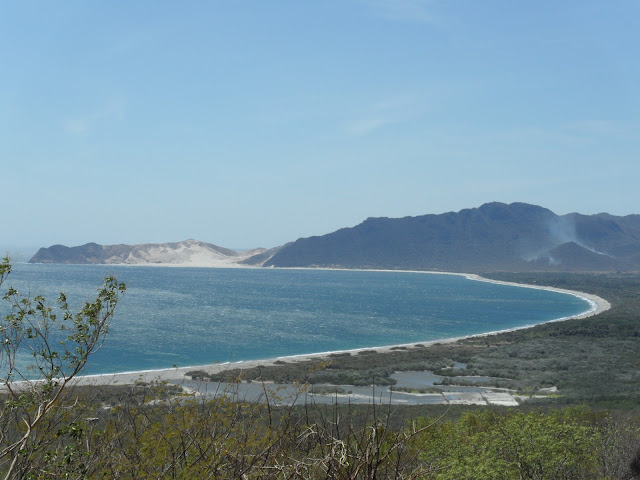On my way to Playa Zipolite I met three Russians on the side of the road while they were hitchhiking. They asked me if I was on my way to the Rainbow gathering. I said "what rainbow gathering?"
I rolled into town and found a nice spot to put my tent on the beach and spent the next 5 days exploring Zipolite and another beach town called Mazunte about 5 km north. I met some more friendly hippies who told me about this 'rainbow healing gathering' on a isolated beach about 150km further south down the coast. I was interested in checking out this gathering because it was said to be on a paradisical beach with a fresh water lagoon and also because it was supposed to be a "healing gathering" free of intoxicants. Based on my past experience at rainbow gatherings I was feeling a little bit cynical and disillusioned about the rainbow tribe phenomenon. Although there are many admirable qualities which the idealistic sub-culture known as the 'Rainbow family' promotes there always seemed to be a healthy dose of laziness and perhaps a collective self-rightious attitude which does not provide viable solutions to perceived problems of mainstream society in which they oppose. Even though I figured the scene might be annoying I knew it would at least be an interesting experience. So I took a bus to the nearest village and then rode my bike to playa San Diego. The location of this gathering was incredible, a perfect isolated beach with a fresh water lagoon merging with the far end of the beach. I was also pleased to find that everyone was quite freindly and open, the scene was very soft and relaxed. At around 11pm on my second night camping a friend from Scotland woke me from my sleep to say that there was a forest fire approaching and that I should pack my stuff and get out of there. I quickly got out of my tent and walked to the beach and saw a massive fire maybe 500m in the distance. There were powerful winds blowing in the direction of our camp and we could see that the fire was approaching very fast. I ran back to my tent and packed everything up and made my way down the beach in the opposite direction of the fire. About an hour later the fire engulfed the spot I was camped at and continued to burn until it reached the lagoon. I stayed awake until the early morning laying in my sleeping bag on the beach watching the incredible light show provided by the massive transient body of fire,. I left the next morning, deciding that the gathering was over for me. I then continued south along the coast and rode to the port city Salina Cruz and got a bus to San Cristobal de Las Casas in Chiapas.
Playa San Diego, Oaxaca


 |
| not sure what these silly hippies are up to... |

San Jose del Pacifico, the mushroom town

Playa Zipolite

 |
| front porch, Zipolite |

 |
met these grizzly looking guys in Mazunte, they were riding from Alaska to Argentina |
San Cristobal de Las Casas
While in San Cristobal I used some time to learn a bit about Chiapas and the Zapatista movement. This movement is named after Emiliano Zapata who was an important figure of the Mexican revolution, which broke out in 1910. He formed and commanded an important revolutionary force, the Liberation Army of the South, during the Mexican Revolution.
The Zapatista Army of National Liberation is a revolutionary leftist group, based in Chiapas, the southern most state in Mexico, it is a rebal movement fighting for the rights of los indios de México (the indigenous peoples of Mexico). On January, 1994 when the North America Free Trade Agreement (NAFTA) became effective, Subcommander Marcos led an army of Mayan farmers into Eastern Chiapas state to protest the federal government's mistreatment of indigenous people.
'The preparations for NAFTA included cancellation of Article 27 of Mexico's constitution, the cornerstone of Emilio Zapata's revolution of 1910–1919. Under the historic Article 27, Indian communal landholdings were protected from sale or privatization. But under NAFTA this guarantee was defined as a barrier to investment. With the removal of Article 27, Indian farmers would be threatened with loss of their remaining lands, and also flooded with cheap imports (substitutes) from the US. Thus, the Zapatistas labeled NAFTA as a "death sentence" to Indian communities all over Mexico. Then EZLN declared war on the Mexican state on January 1, 1994, the day NAFTA came into force.'(wikipedia)
'Another key element of the Zapatista ideology is their aspiration to do politics in a new, participatory way, from the "bottom-up" instead of "top-down." The Zapatistas consider the contemporary political system of Mexico inherently flawed due to what they consider its purely representative nature and obvious disconnection from the people and their needs. Instead, the EZLN claims to reinforce the idea of participatory democracy or radical democracy by limiting public servants' terms to only two weeks, not using visible organization leaders, and constantly referring to the people they are governing for major decisions, strategies and conceptual visions. As Marcos has reiterated, "my real commander is the people". In accordance with this principle, the Zapatistas are not a political party: they do not seek office throughout the state, because that would perpetuate the political system by attempting to gain power within its ranks. Instead, they wish to reconceptualize the entire system.'(wikipedia)
 |
| Subcomandante Marcos |
 |
| Emiliano Zapata |
San Cristobal was a enjoyable place to spend a few days. The city maintains it's colonial Spanish architecture and layout with old churches and narrow cobblestone streets. San Cris is said to be the cultural capital of the state and there is a large indigenous population which makes it a popular tourist destination.
Palenque











